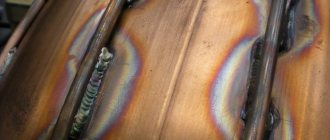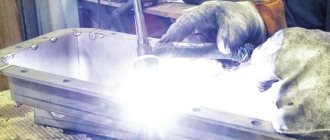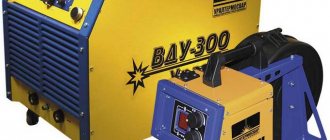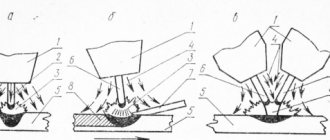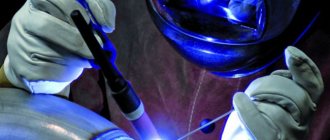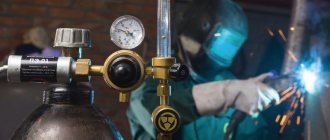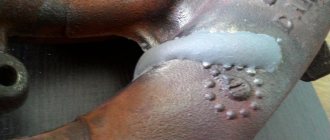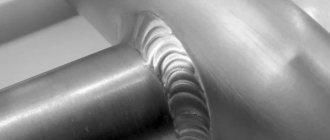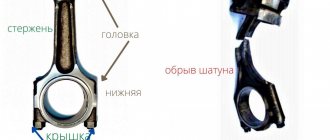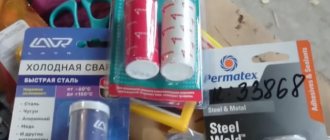Features of welding aluminum with argon
When performing work, you need to take into account the unusual characteristics of this metal:
- Due to increased chemical activity, the surface of aluminum upon contact with air is quickly covered with an oxide film. It melts at a temperature of more than 2000⁰C, and metal - 660⁰C. If hard pieces of film get into the seam, its strength will decrease.
- When welding aluminum, it is difficult to control the process, since its color does not change after melting.
- The material is hygroscopic, therefore it absorbs atmospheric moisture, which, when heated, evaporates from the surface, reducing the quality of the connection.
- Due to the high coefficient of linear expansion, the joint may become deformed and crack when cooling. To compensate for shrinkage, argon welding is carried out with increased wire consumption or the seam is modified.
- If the gas flow is incorrectly adjusted when performing argon welding of aluminum, it foams when there is a shortage, and when there is an excess, it makes it difficult to form a seam.
Properties of aluminum
To achieve a positive result when TIG welding aluminum with argon, it is necessary to take into account the properties and characteristics of the metal. This will help to correctly configure the machine for welding aluminum with argon, as well as select the appropriate electrode and filler material.
Aluminum is characterized by activity - when interacting with oxygen contained in atmospheric air, a refractory oxide film is formed on the surface of the product, preventing further oxidation.
An interesting feature that should be taken into account is the stability of the surface color, regardless of the temperature and mode of manual argon arc welding of aluminum. This creates difficulties in assessing the degree of heating, which can lead to surface burns.
When planning work, it is necessary to take into account the volumetric shrinkage coefficient. The percentage depends on the purity of the metal. For some alloys the value reaches 6.6% - compared to other metals and alloys, the figure is much higher. This property negatively affects the process of seam formation and can lead to large internal stresses during local heating.
Aluminum filler material selection table
How to use the table:
- Select the main alloys that will be welded together (the first alloy from the vertical column, the second from the horizontal row).
- Find the block at the intersection of these rows and columns.
- This block has horizontal rows with indices (5, 4, 3 or 2) located opposite the filler material options in the corresponding cells at the beginning and end of each row. These indices give a rating score in points from 2 to 5 to the corresponding criteria located in the second line from the top in each of the columns with the indices S, P, E, K, T and A (see explanations for each of the indices in the right table).
- The analysis is carried out for each of the possible filler materials. Based on this, you can select a filler material that will provide the best combination of characteristics for you.
Necessary equipment and materials
To operate, you will need a device that produces alternating current, since welding aluminum with direct current using the argon method cannot be carried out. The best option would be an inverter with a TIG mode and a set of options allowing:
- ignite an arc without contact;
- weld a crater at the end of the seam;
- adjust current balance;
- set the period of time during which the argon supply continues after the arc is turned off.
To reduce gas consumption for welding aluminum, you need to acquire a torch with a gas lens (collet holder), inside of which a mesh is placed. When argon passes through the cells, protection of the welding site is improved at lower consumption. To install lenses, nozzles of several diameters are available; the larger the size, the more reliable the protection.
Basic welding method
Argon arc welding of aluminum and its alloys (AC TIG) is carried out using alternating current, the source of which, as a rule, is an inverter generator. The inverter not only produces a very precise sine wave current, which is important when welding, but is also very compact. In addition to the inverter itself, the device includes:
- gas cylinder (argon or argon + helium);
- TIG torch;
- gas hoses;
- cables.
The AC TIG machine operates using tungsten non-consumable electrodes and filler wire. The standard welder’s kit also includes a shield (preferably “Chameleon” and protective leggings). The device provides adjustment of welding current and gas flow. But welding modes will be discussed below.
Setting up an argon apparatus
First, the gas flow is adjusted in the range of 6 - 12 l/min using the pressure gauge, which is closer to the hose. When working indoors, the value is set to 1.5 times less than outdoors. Excessive flow creates turbulent turbulence, which mixes gas with air, thereby reducing the reliability of protection of the welding zone.
Depending on the thickness of the workpieces, the current setting of the machine for argon welding is carried out according to the table:
| Metal thickness, mm | Current value, A | Tungsten electrode diameter, mm |
| 1 | 30 — 40 | 1,6 |
| 1,5 | 45 — 60 | 2,3 |
| 2 | 70 -80 | 2,3 |
| 3 | 90 — 120 | 3,2 |
For aluminum the polarity is set to 50/50. However, when working with pure metal, in order to obtain a thin seam and less heating of the electrode, the current balance regulator is shifted towards negative values. For alloys it is better to use the positive range, but without getting carried away. Alternating current with a large positive half-wave is detrimental to the electrode.
The arc decay time when welding a crater, depending on the thickness of the workpiece, is set to 2 - 4 seconds. The duration of argon supply after welding is completed is 3 - 5 seconds.
Welding aluminum with direct and alternating current
Aluminum and its alloys are characterized by lightness, strength, and corrosion resistance. This complex of properties makes the metal widely in demand in various industries. Welding of aluminum products is carried out using almost all known industrial methods. It is possible to work with direct current of reverse polarity and with alternating current.
Features of working with metal
Welding aluminum with direct or alternating current is accompanied by the formation of a protective oxide film on the surface of the metal. Aluminum oxide is a refractory compound. It negatively affects the stability of the welding process and reduces the strength of the weld (lack of penetration is formed). This feature requires a careful approach to the selection of materials and working methods.
So, it is better to work with tungsten electrodes using alternating current. Direct current also allows you to weld aluminum, but subject to reverse polarity. The destruction of the refractory film occurs during the half-cycle of reverse polarity. Straight polarity means a large amount of spatter, problems with arc stabilization and black deposits on the surface of the seam (burn-throughs).
AC welding of aluminum
Aluminum welding with alternating current is carried out in an argon or helium environment. Current operating mode is TIG.
Experts advise using the arm's length method, but without the electrode leaving the protective environment.
TIG welding is used for the manufacture of aluminum metal structures in the chemical, food, aviation industries, and in some nuclear technologies. Aluminum wire is used as an additive. Thin sheets can be welded without additives.
Process Features:
- The angle of inclination of the burner in the vertical plane is not less than 15 and not more than 40 degrees.
- Gas flow can reach 12 l/min depending on the nozzle diameter.
- At the end of welding, gas is purged to protect the seam and cool the tungsten electrode.
When argon arc welding, it is recommended to connect the oscillator in addition to the main power source to facilitate ignition. The device applies high-frequency, high-voltage pulses to the electrode, which help ionize the shielding gas. After the arc is ignited, the oscillator operates in stabilizer mode, delivering pulses only during a polarity change. This allows for more even combustion.
DC welding
Welding of aluminum with direct current of reverse polarity is carried out in the MIG mode.
It is better to use pulse-arc machines that have a program for welding aluminum alloys.
Argon is used to create an inert environment. The positive pole is connected to the electrode, and the negative pole to the metal structure.
Reverse polarity is needed to create a thermal load at which the oxide film melts. This ensures reliable welding of the edges of the product. The disadvantage of this method is the inability to control the current density.
Features of AC welding:
- The vertical angle of the burner should be in the range of 10-20 degrees.
- Do not allow air to enter the shielding gas environment.
- The nozzle should be at a distance of 10-15 mm from the metal.
There are technologies for argon-free welding with electrodes based on metal chlorides and fluorides. These connections stabilize the arc and allow the oxide film to melt.
When choosing a welding method for aluminum and its alloys, they are guided by the purpose of the products and their operating conditions. The quality of the weld must be optimal for the specific conditions.
steelguide.ru
Preparing parts for welding
Before starting to weld parts, they are cleaned of dirt and grease with any solvent. The oxide film is removed with a brush with metal bristles or a file. The use of abrasive tools is not recommended. The grains remaining in the scratches will get inside the seam, which will not have the best effect on its quality. The edges of thick aluminum (more than 4 mm) are chamfered at an angle of 45 - 65⁰.
To remove moisture, the workpieces are heated to 150⁰C. To reduce the risk of burning through thin metal to zero, steel or copper plates are placed under the workpieces. They improve heat dissipation, which speeds up the process, thereby saving energy and gas. Welding in an argon environment is carried out immediately after preparation so that the aluminum does not have time to oxidize.
What equipment and technologies are used for aluminum welding
Before performing work, it is recommended to take special training courses in argon welding of aluminum. The program includes theoretical and practical classes, including safety rules. The only drawback of such courses is the long training period. In addition, constant practice is required to improve the technique of argon arc welding.
The following joining methods are used as alternative aluminum welding methods:
- Gas welding - involves the use of filler rods and flux, which protects the melt zone.
- Manual arc welding with coated electrodes is rarely used due to the poor quality of the seam.
- Semi-automatic electrode wire welding is a worthy alternative that allows you to obtain a reliable and durable connection.
The process of welding aluminum with argon: step-by-step instructions
The main thing for beginners mastering this technology is strict adherence to simple rules:
- To create an even seam, the workpieces are pre-grabbed on both sides.
- The filler wire is fed after the weld pool appears. It is important not to hesitate so as not to burn a hole in the metal.
- When welding aluminum with argon, the arc length is maintained at 3 mm.
- The electrode is placed at an angle of 80⁰, and the wire is perpendicular to it. To prevent aluminum from splashing, it is fed smoothly, without jerking.
- If thin aluminum is being welded, the electrode is guided along the joint without lateral movements. When working with workpieces thicker than 3 mm, zigzag vibrations are allowed.
- Argon welding technology involves the movement of the wire in front of the electrode.
- The seam is completed by pressing a button on the machine, which turns on the arc decay timer.
- The burner position is not changed until the end of argon purging.
- A properly made seam has a ribbed surface without pores or cracks.
Having mastered the technology of argon arc welding of aluminum, you can make good money. For 1 cm of such a connection they pay 45 or more rubles. But to become a sought-after specialist, you will first have to train to learn how to create reliable seams.
Advantages
- Inert gas is the best protective medium at the moment, which creates conditions impenetrable to oxygen and hydrogen;
- There is no risk of moisture getting into the weld pool from the electrode coating;
- The arc has high combustion stability;
- The seams are more neat and thin, and the welding joints are stronger;
- Many of the disadvantages of aluminum weldability become less significant;
- Ability to work with a wide range of settings modes.
Inverter for welding
The concept of inverter includes a device whose function is to convert direct current into alternating current. It can also change the frequency of alternating current.
Advantages of using welding inverters:
- Increases efficiency when working with a welding machine.
- The design of welded parts becomes more reliable.
- The seams become reliable and durable.
- Compactness allows you to easily carry the device to your work site.
- High efficiency increases process productivity.
- Electricity consumption is moderate.
- Possibility of regulating smooth current supply.
- Ease of control.
Argon welding with an inverter requires a special type of this device. It must have a function for connecting a burner, which has hoses through which gas is supplied. Argon welding with an inverter makes it possible to weld steel using direct current and aluminum using alternating current.
Advantages and disadvantages of welding in argon environment
The advantages of argon arc welding include:
- Reliable protection of the weld pool;
- Possibility of joining dissimilar metals;
- Visual control of seam quality;
- Accuracy of work execution;
- Welding is carried out in all spatial positions.
Along with the advantages, there are a number of disadvantages:
- Qualification requirements for a welder;
- The need to purchase expensive equipment;
- Low work productivity.
Application
The advantages of TIG welding of metals find its application in the following industries:
- mechanical and instrument engineering;
- food production;
- oil industry;
- chemical industry;
- drilling rigs;
- construction of metal structures for high-rise buildings;
- steel frame structures;
- pipelines;
- aviation;
- astronautics;
- aircraft manufacturing;
- shipbuilding.
Argon TIG welding is also used for less global solutions. It is often used in domestic conditions. An example is installing an air conditioner in a car or repairing cracks in a car radiator. In all homes there are kitchen utensils and metal towel rails made using this method.
TIG argon welding has become so widespread due to the fact that it can be used to weld both carbon steel and non-ferrous metals, while maintaining excellent weld quality.
Safety regulations
When welding, we must not forget about safety rules. It is necessary to use protective equipment for the welder: a mask or shield, gloves or leggings, special clothing and shoes.
All masks can be divided into active and passive. The sight glass of passive masks is permanently darkened. In active ones, darkening occurs only as a reaction to a light flash from the arc. The advantage of this option is that while the welding process is stopped, the glass becomes transparent and the welder can clearly see the object. There is no need to lift the glass, which is quite convenient.
Main types of welding gaiters:
- Canvas . They are not in demand because they do not perform well the main function of protecting hands from high temperatures and sparks. They easily burn when exposed to sparks.
- Split fibers . Made from specially treated leather from pigs or cows. Resistant to flying sparks. Durable, elastic, hygienic. Does not restrict hand movements. If there is a cotton layer inside, it keeps your hands warm.
- Felt . Convenient for welding work.
There are combined models that use different types of materials. Welding gaiters come in length up to the elbow and cover only the hand. The possibility of tightening the edge of the glove provides additional safety.
A welder's suit must be made of high quality materials. It must be resistant to splashes of molten metal. The requirements for a welder's suit are specified in GOST 12.4.250. The main parts of the suit are the jacket and trousers. The material from which they are made must have great heat resistance. According to the regulatory material, the jacket must cover the trousers by more than 20 cm. The fasteners are closed with flaps. The maximum distance between them on the jacket is 15 cm.
Safety regulations include electrical safety. The argon cylinder must be located at a distance of at least 5 meters from possible sources of fire. The cylinder must be placed vertically and secured to prevent it from falling. Before work, it is necessary to check the condition of the hoses.

